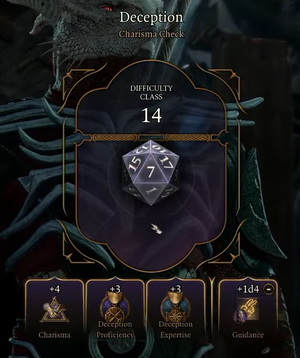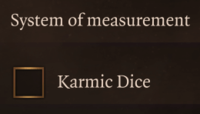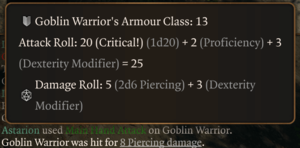Die Rolls

Кидки кісток[ред. | ред. код]
Від англ. Die (Dice) Rolls, також перекладають як кидки кубиків.
Атака на істоту, спроба штовхнути, виявити прихований секрет і зламати замок — все це приклади кидків кісток, які є основним методом, що використовується для визначення успіху або поразки персонажа. Кількість шкоди, яку персонаж завдає в бою, також визначається кидком кістком.
У більшості випадків, коли персонаж кидає кістку, його модифікатор здібностей і бонус майстерності додаються до результату, щоб визначити остаточний результат. Найпоширенішим винятком є кидок шкоди, який не додає бонус навичок персонажа, якщо це явно не вказано.
Різні типи кісток, що використовуються в кидках, позначаються за кількістю граней, які вони мають:
![]() D4,
D4,
![]() D6,
D6,
![]() D8,
D8,
![]() D10,
D10,
![]() D12 і
D12 і ![]() D20. Скорочення використовуються для позначення загальної кількості кубиків, що використовуються в кидку, наприклад, 1к6 (чи 1d6) для кидка одного кубика D6, 2к4 (2d4) для кидка двох кісток D4, 8к6 (8d6) для кидка восьми кубиків D6 і так далі.
D20. Скорочення використовуються для позначення загальної кількості кубиків, що використовуються в кидку, наприклад, 1к6 (чи 1d6) для кидка одного кубика D6, 2к4 (2d4) для кидка двох кісток D4, 8к6 (8d6) для кидка восьми кубиків D6 і так далі.
Деякі кидки повинні досягти певного значення, щоб вважатися успішними. Зазвичай це робиться за допомогою ![]() D20, а цільове значення називається Межа складності кидка. Випадання 1 на D20 називається «природна 1», а випадання 20 — «Природна 20». На деяких кидках це може мати особливі ефекти, такі як автоматичний провал або успіх кидка, ігнорування модифікаторів та класу складності.
D20, а цільове значення називається Межа складності кидка. Випадання 1 на D20 називається «природна 1», а випадання 20 — «Природна 20». На деяких кидках це може мати особливі ефекти, такі як автоматичний провал або успіх кидка, ігнорування модифікаторів та класу складності.
Кармічні кістки[ред. | ред. код]

Якщо опція Кармічні кістки увімкнена (за замовчуванням), гра уникатиме розчаровуючих смуг дуже низьких випадінь поспіль.
Однак, кармічні кубики впливають на всі кидки, включаючи кидки ворогів, і результати завжди будуть схилятися в бік позитивного результату для гравця, який кидає кубики. Коротше кажучи, кармічні кубики роблять бойові сутички швидшими і смертоноснішими як для вас, так і для ваших ворогів.
Точний алгоритм гри кармічних кісток наразі невідомий і може змінюватися між версіями гри.
Раніше кармічні кістки називали «зарядженими».
Типи кидків[ред. | ред. код]
Окрім загальних принципів, описаних вище, деталі кидків залежать від типу кидка, який виконується. Нижче наведені типи кидків у грі.
Кидок атаки[ред. | ред. код]
Основна сторінка: Кидок атаки

Ця сторінка є заглушкою. Ви можете допомогти нашій вікі, розширивши її. Дивіться розділ довідки про те, як зробити свій внесок..
Коли істота когось атакує, розігрується D20. До результату кидка додаються Ability Score Modifier та Proficiency Bonus персонажа, що атакує. Якщо результат рівний або перевищує Клас Захисту цілі, атака є успішною. Якщо ні, атака вважається неуспішною; це може означати, що атака промахнулась, не завдала шкоди цілі через її броню або те, що ціль змогла ухилитись чи парирувати.
Атаки, вчинені Зброєю завжди використовують Кидок атаки для визначення успіху. Деякі закляття також застосовують Кидок атаки для визначення того, що влучили вони в бажану ціль (такі як ![]() Fire Bolt чи
Fire Bolt чи ![]() Eldritch Blast), хоча інші закляття можуть влучати по цілі автоматично (такі як
Eldritch Blast), хоча інші закляття можуть влучати по цілі автоматично (такі як ![]() Magic Missile чи
Magic Missile чи ![]() Fireball). Закляття, що автоматично влучає в ціль, може дозволяти цілі кинути натомість Рятівний кидок; дивіться нижче.
Fireball). Закляття, що автоматично влучає в ціль, може дозволяти цілі кинути натомість Рятівний кидок; дивіться нижче.
Кидок атаки не слід плутати з Кидком шкоди, який натомість визначає кількість нанесеної цілі шкоди в разі успішно проведеної атаки.
Критичний промах / Критичний удар[ред. | ред. код]

Як виняток, випадання 1 означає, що атака не вдалась, незалежно від Класу захисту цілі. Це так званий Критичний промах.
Так само, випадання 20 означає, що атака стає успішною, незалежно від Класу захисту цілі. Це так званий Критичний удар. Критичний удар також впливає на результат Кидка шкоди. На даний момент, Критичний удар подвоює кількість дайсів, задіяних у Кидку шкоди (including additional dice such as those from Smites or Combat Maneuvers), але не бонуси від модифікаторів чи інші бонуси простої шкоди, такі як ![]() Great Weapon Master: All In.
Great Weapon Master: All In.
Модифікатори Кидка атаки[ред. | ред. код]
The Ability Score used for the Ability Score Modifier depends on the type of attack that's being made. Melee and ranged weapon attacks use Strength or Dexterity, depending on the weapon. For spells, the Ability Score used for the Modifier generally depends on the class of the caster; see the main Attack Roll page for details.
For the creature's Proficiency Bonus to be added to the roll, the creature must be proficient in the kind of attack it's making. For weapon attacks, this is based on whether the creature has proficiency in the weapon being used. For spells, it's based on whether the creature has any innate spell casting capability granted by its class, subclass, or Feats.
Attack Rolls can also have ![]() Advantage /
Advantage / ![]() Disadvantage.
Disadvantage.
Кидок шкоди[ред. | ред. код]
Основна сторінка: Кидок шкоди
Кидок шкоди розігрується, коли проходить успішна атака, закляття влучає в ціль, спрацьовує пастка, і так далі. Результат визначає вчинену шкоду у вигляді хіт-поінтів. Цей кидок може розігруватись різними типами дайсів та їх кількістю.
For example, a successful hit with a Dagger will lead to a D4 being rolled to determine the damage (referred to as 1d4 damage), whereas a successful attack with a Greatsword will lead to two D6 being rolled (referred to as 2d6) for a total damage of 2 to 12. Being caught in a ![]() Fireball will cause 8d6 points of damage, though a successful Saving Throw (see below) can reduce it to half.
Fireball will cause 8d6 points of damage, though a successful Saving Throw (see below) can reduce it to half.
Модифікатори Кидка шкоди[ред. | ред. код]
For attacks made with weapons, the total value resulting from the roll is affected by the attacking creature's Ability Score Modifier. For the damage of spell attacks, no such modifier applies, except when explicitly granted by a magical item or class feature, such as the Warlock's ![]() Agonising Blast invocation.
Agonising Blast invocation.
Рятівний кидок[ред. | ред. код]
Основна сторінка: Рятівний кидок
Various types of danger can be avoided, or their harm reduced, by making a ![]() Saving Throw, also called a save. This could mean trying to avoid damage from a trap that was just activated, trying to resist the poison of a venomous bite, or trying to take cover to reduce damage from an explosion.
Saving Throw, also called a save. This could mean trying to avoid damage from a trap that was just activated, trying to resist the poison of a venomous bite, or trying to take cover to reduce damage from an explosion.
The creature rolls a D20, and adds its Ability Score Modifier and Proficiency Bonus (if Proficient in that type of saving throw). The result must reach or exceed the Difficulty Class of the Saving Throw.
Saving Throw Modifiers[ред. | ред. код]
Which Ability Score is used for the Modifier depends on the source of danger against which the save is being made. For example, evading a spike trap may require Dexterity, whereas trying to resist the effects of a poisonous gas would require Constitution.
Depending on the Ability Score, the Saving Throw may be referred to as a Strength Saving Throw, Dexterity Saving Throw, Constitution Saving Throw, and so on. (Further shortened to Strength Save, Dexterity Save, etc.) The Proficiency Bonus is only added if the creature has Proficiency in the corresponding type of Saving Throw. Each Class grants a creature two Saving Throw Proficiencies.
Difficulty Class[ред. | ред. код]
The Difficulty Class is also determined by the source of danger. If a creature casts a spell that imposes a Saving Throw on another, the Difficulty Class is determined by the spell caster's Modifiers, using the following formula:
In other scenarios, such as traps, the game chooses an appropriate Difficulty Class, depending on how serious the danger is.
Effect of Success[ред. | ред. код]
A successful save could mean completely avoiding negative effects, or it could mean reducing the damage received. For example, successfully saving against a spike trap could mean that a creature takes no damage at all, because it successfully evaded the spikes. On the other hand, if it's caught in the area of effect of a ![]() Fireball, then a successful save will merely halve the damage. Some effects don't allow for a Saving Throw at all, for example the damage taken from
Fireball, then a successful save will merely halve the damage. Some effects don't allow for a Saving Throw at all, for example the damage taken from ![]() Magic Missile.
Magic Missile.
Ability Check[ред. | ред. код]
Main page: Ability Check
Various actions, other than attacking or making a save, still require the creature to make an attempt that may fail. The creature rolls a D20, and adds its Ability Score Modifier and possibly its Proficiency Bonus. The attempted action has a specific Difficulty Class which the result of the roll must match or exceed.
Ability Checks can be based purely on an Ability Score, in which case they can only benefit from the Ability Score Modifier, but not the Proficiency Bonus.
Skill Check[ред. | ред. код]
More commonly, the check will be related to a specific Skill, which not only determines the Ability Score used for the Modifier, but also lets the creature use its Proficiency Bonus if it happens to be Proficient in that particular Skill. In this case, the check may be called a Skill Check rather than an Ability Check.
For example, when a trap is near a creature, and it's not yet activated, the game rolls a Perception Skill Check (or in short, "rolls Perception") to determine whether the creature notices the trap. Perception is related to Wisdom, so a creature with high Wisdom will gain a bonus. If the creature doesn't gain any bonus from Wisdom, it could still gain a bonus from being Proficient in the Perception Skill. If the creature both has high Wisdom and is proficient in Perception, it gains both bonuses.
Once the trap is seen, the creature may want to disarm it. This will require a Sleight of Hand Check, which is related to Dexterity. So, a creature that both has high Dexterity, and Proficiency in Sleight of Hand, can benefit from both types of bonuses when attempting to disarm the trap.
Contest[ред. | ред. код]
A Contest is a special type of Ability Check in which two creatures both roll an Ability Check or Skill Check to oppose each other, and one wins over the other. The creatures don't necessarily roll the same type of check.
An example of this is the ![]() Shove action, where the creature attempting the Shove must roll Athletics, and the defending creature is allowed to roll either Athletics or Acrobatics to contest the Shove. If the attacker's roll is higher than the defender's, the Shove succeeds, otherwise it fails.
Shove action, where the creature attempting the Shove must roll Athletics, and the defending creature is allowed to roll either Athletics or Acrobatics to contest the Shove. If the attacker's roll is higher than the defender's, the Shove succeeds, otherwise it fails.
Модифікатори[ред. | ред. код]
Rolls can be modified by various bonuses and penalties. These can take the form of adding or subtracting a value from the result, or requiring two rolls instead of one and taking the lower or higher of the two values.
Advantage / Disadvantage[ред. | ред. код]
Main page: Advantage
In various situations, a creature can have ![]() Advantage or
Advantage or ![]() Disadvantage on an Attack Roll, Saving Throw, or Ability Check.
Disadvantage on an Attack Roll, Saving Throw, or Ability Check.
Advantage means that you make the roll twice and use the higher result. Disadvantage means you use the lower result.
Advantage and Disadvantage cannot stack. In other words, you never roll more than twice. Additionally, they cancel each other out, no matter how many sources of Advantage or Disadvantage you have. For instance, if you had three sources of Advantage and only one source of Disadvantage, they would still cancel each other out, causing you to roll normally.
Ability Score Modifier[ред. | ред. код]
Main page: Ability Score Modifier
A creature's Ability Scores can modify the result of rolls, depending on how high or low the Ability Score is. Which Ability Score is used to determine the Modifier depends on the roll that's being made. The Ability Score Modifier for a specific Ability Score can also be referred to by the name of that Ability Score, such as: Strength Modifier, Dexterity Modifier, etc.
For Attack Rolls[ред. | ред. код]
Weapon attacks will generally use Strength or Dexterity, depending on the weapon and the type of attack made. See Attack Roll for details.
Spell attacks will use an Ability Score depending on the Class of the creature making it. Again, see the Attack Roll page for details.
For Damage Rolls[ред. | ред. код]
For Weapon attacks, the same rules apply to Damage Rolls as for Attack Rolls. If the Damage Roll involves multiple dice, such as the 2d6 damage of a Greatsword, then the Modifier is applied to the total value, not to each individual die.
For the damage of Spells, there is generally no Ability Score Modifier, though there are exceptions to this rule. For example, ![]() Agonising Blast allows the Warlock to add its Charisma Modifier to the damage of
Agonising Blast allows the Warlock to add its Charisma Modifier to the damage of ![]() Eldritch Blast.
Eldritch Blast.
For Saving Throws[ред. | ред. код]
For saves against various threats, the threat in question determines which Ability Score is used to make the save. For example, the ![]() Web spell requires you to make a Dexterity Save, whereas
Web spell requires you to make a Dexterity Save, whereas ![]() Crown of Madness requires a Wisdom Save.
Crown of Madness requires a Wisdom Save.
An Ability Score Modifier is also used when a creature imposes a Saving Throw on another, such as by casting a spell. The Modifier affects the Difficulty Class (DC) of the Save imposed on the target, using the formula:
This allows spellcasters to increase the effectiveness of their spells by increasing their Spellcasting Ability Modifier, even when those spells do not involve Attack Rolls.
Note: The Ability Score used to determine the Spell Save DC is not necessarily the same as the type of Saving Throw imposed on targets. Instead, much like for Attack Rolls, it uses the caster's Spellcasting Ability Modifier. For example, a Wizard's Spell Save DC is determined by their Intelligence modifier, but a creature targeted by a ![]() Web spell cast by a Wizard must still make a Dexterity Save.
Web spell cast by a Wizard must still make a Dexterity Save.
For Ability Checks[ред. | ред. код]
An Ability Check is always based on a specific Ability Score, which determines the Modifier that will be used. The Skill Check also uses an Ability Score Modifier, since each Skill is based on a specific Ability Score. For example, an Athletics Check uses Strength, whereas a Sleight of Hand Check uses Dexterity.
Proficiency Bonus[ред. | ред. код]
Main page: Proficiency Bonus
Creatures can have Proficiency in a number of different areas, allowing them to add their ![]() Proficiency Bonus to related rolls. Proficiencies can be granted by a creature's Background, Race, Class, and Feats chosen when leveling up.
Proficiency Bonus to related rolls. Proficiencies can be granted by a creature's Background, Race, Class, and Feats chosen when leveling up.
For Attack Rolls[ред. | ред. код]
Attack Rolls made with Weapons can benefit from Proficiency with the type of weapon that's being used. This kind of Proficiency can be granted by the creature's Race, Class, or Feats chosen when leveling up.
Attack Rolls made for spells benefit from Proficiency in spell casting, which all creatures capable of casting spells have. The creature could have spell casting capabilities due to its Class, or from a Feat it chose when leveling up.
For Saving Throws[ред. | ред. код]
A creature can have Proficiency in a specific type of Saving Throw, like Strength Saving Throws or Dexterity Saving Throws. Each Class gains Proficiency in two such types of Saving Throw at level 1, and can add their Proficiency Bonus to those types of Saving Throws.
A creature's Proficiency Bonus also affects the Difficulty Class of the Saving Throw that enemies must roll when affected by that creature's spells (and some non-spell abilities). The formula for this is:
For Ability Checks[ред. | ред. код]
An Ability Check may be based directly on an Ability Score rather than a Skill, in which case no Proficiency Bonus is possible. If it's based on a Skill, however, a creature will get a Proficiency Bonus in the corresponding Skill Checks if it's Proficient in that Skill.
Proficiency in a Skill can be granted by Race, Class, or a Feat chosen when leveling up. For example, all Elves have an innate feature called Keen Senses which grants them Proficiency in Perception. Rangers can gain Proficiency in a number of skills based on class features they choose: Bounty Hunter grants Proficiency in Investigation, Keeper of the Veil and Mage Breaker both grant Proficiency in Arcana, and so on. The Skilled Feat, if chosen when leveling up, allows a creature to gain Proficiency in any three Skills.
| ||||||||||||||||||||||||||